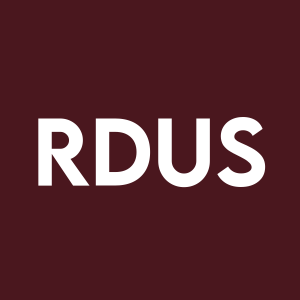Second Quarter Fiscal 2024 Preliminary Results and Announcement of Earnings Date
Nonferrous and Finished Steel Sales Volumes Up Year-over-Year
Cost Reduction Target Increased
PORTLAND, Ore., March 14, 2024 (GLOBE NEWSWIRE) -- Radius Recycling, Inc. (NASDAQ: RDUS) today announced preliminary results for its fiscal 2024 second quarter ended February 29, 2024.
Second Quarter Fiscal 2024 Expected Performance
The Company anticipates:
- Net loss to be approximately
$(35) million . Loss per share from continuing operations to be in the range of$(1.19) -$(1.24) . - Adjusted EBITDA to be approximately
$2 million , and adjusted loss per share from continuing operations to be in the range of$(1.05) -$(1.10) .
Market Conditions, Prices, and Volumes. Tight supply flows for recycled metals and unusually wet winter weather impacted sales volumes and metal spreads for both recycled metals and finished steel during the Company’s second quarter. Ferrous sales volumes are expected to decrease sequentially by
Finished steel sales volumes are expected to increase by
Average net selling prices for ferrous recycled metals are expected to be up
Productivity Initiatives and Cost Reductions. During the second quarter, the Company implemented a plan to reduce selling, general and administrative (“SG&A”) expense by
Operating Cash Flow. Operating cash outflow for the second quarter is expected to be in a range of
Tamara Lundgren, Chairman and Chief Executive Officer, said, “Without question, current market conditions remain challenging as cyclical headwinds are creating tighter supply flows and compressing metal spreads. We have navigated effectively through these periods of tight scrap availability before, and we are focused on what we can control: costs, operating efficiencies, and execution of our strategic priorities to increase our nonferrous production and expand our recycling services platform.”
She continued, “Scrap supply flows should improve with normal seasonality and benefit as U.S. interest rates decline and global manufacturing activity recovers. On the demand side, decarbonization trends continue to be a positive driver for our products and services. Many low carbon technologies are more metal intensive than the technologies they are replacing and recycled metals require less carbon to produce than mined metals. With our 100+ operating facilities producing recycled ferrous volumes of over four million tons and nonferrous volumes of over 700 million pounds annually, our low carbon and net zero carbon emission GRNTM finished steel products, and our 3PRTM service and supply chain solution that enables our customers to increase their recycling rates, we are well-positioned to benefit from market improvements and these positive structural demand trends.”
The preliminary information provided above is based on the Company’s current estimates of its financial results for the quarter ended February 29, 2024, and remains subject to change based on final review of the Company’s second quarter financial results.
Earnings Call Date
The Company will report financial results for its fiscal 2024 second quarter ended February 29, 2024 on Thursday, April 4, 2024. The Company will host a webcast conference call to discuss the results at 11:30 a.m. Eastern Time on the same day. The webcast of the call and the accompanying slide presentation may be accessed at www.radiusrecycling.com/company/investors on Radius Recycling’s website under Company > Investors. The call will be hosted by Tamara Lundgren, Chairman and Chief Executive Officer, and Stefano Gaggini, Senior Vice President and Chief Financial Officer.
About Radius Recycling, Inc.
Radius Recycling, Inc. (formerly Schnitzer Steel Industries, Inc.) is one of the largest manufacturers and exporters of recycled metal products in North America with operating facilities located in 25 states, Puerto Rico, and Western Canada. Radius has seven deep water export facilities located on both the East and West Coasts and in Hawaii and Puerto Rico. The Company’s integrated operating platform also includes 50 stores which sell serviceable used auto parts from salvaged vehicles and receive over 4 million annual retail visits. The Company’s steel manufacturing operations produce finished steel products, including rebar, wire rod, and other specialty products. The Company began operations in 1906 in Portland, Oregon.
Non-GAAP Financial Measures
This press release contains performance based on adjusted diluted earnings per share from continuing operations attributable to Radius shareholders, adjusted EBITDA, and debt, net of cash, which are non-GAAP financial measures as defined under SEC rules. As required by SEC rules, the Company has provided a reconciliation of these measures for each period discussed to the most directly comparable U.S. GAAP measure. Management believes that providing these non-GAAP financial measures adds a meaningful presentation of our results from business operations excluding adjustments for restructuring charges and other exit-related activities, asset impairment charges, charges for legacy environmental matters (net of recoveries), amortization of capitalized cloud computing implementation costs, business development costs not related to ongoing operations including pre-acquisition expenses, and the income tax benefit allocated to these adjustments, items which are not related to underlying business operational performance, and improves the period-to-period comparability of our results from business operations. We believe that presenting debt, net of cash is useful to investors as a measure of our leverage, as cash and cash equivalents can be used, among other things, to repay indebtedness. These non-GAAP financial measures should be considered in addition to, but not as a substitute for, the most directly comparable U.S. GAAP measures.
| Reconciliation of adjusted diluted loss per share from continuing operations attributable to Radius shareholders | ||||||||
| ($ per share) | ||||||||
| 2Q24 | ||||||||
| High | Low | |||||||
| As reported | $ | (1.19 | ) | $ | (1.24 | ) | ||
| Restructuring charges and other exit-related activities | 0.11 | 0.11 | ||||||
| Asset impairment charges | 0.06 | 0.06 | ||||||
| Charges for legacy environmental matters, net(1) | 0.01 | 0.01 | ||||||
| Business development costs | — | — | ||||||
| Income tax benefit allocated to adjustments(2) | (0.03 | ) | (0.03 | ) | ||||
| Adjusted(3) | $ | (1.05 | ) | $ | (1.10 | ) | ||
- Legal and environmental charges, net of recoveries, for legacy environmental matters including those related to the Portland Harbor Superfund site and to other legacy environmental loss contingencies.
- Income tax allocated to the aggregate adjustments reconciling reported and adjusted diluted loss per share from continuing operations attributable to Radius shareholders is determined based on a tax provision calculated with and without the adjustments.
- May not foot due to rounding.
| Reconciliation of adjusted EBITDA | |||
| ($ in millions) | |||
| 2Q24 | |||
| Net loss | $ | (35 | ) |
| Plus loss from discontinued operations, net of tax | — | ||
| Plus interest expense | 6 | ||
| Plus income tax expense | 1 | ||
| Plus depreciation and amortization | 24 | ||
| Plus restructuring charges and other exit-related activities | 3 | ||
| Plus asset impairment charges | 2 | ||
| Plus charges for legacy environmental matters, net(1) | — | ||
| Plus amortization of cloud computing software costs(2) | — | ||
| Plus business development costs | — | ||
| Adjusted EBITDA(3) | $ | 2 | |
- Legal and environmental charges, net of recoveries, for legacy environmental matters including those related to the Portland Harbor Superfund site and to other legacy environmental loss contingencies.
- Amortization of cloud computing software costs consists of expense resulting from amortization of capitalized implementation costs for cloud computing IT systems. This expense is not included in depreciation and amortization.
- May not foot due to rounding.
| Reconciliation of debt, net of cash | ||||||||
| ($ in millions) | ||||||||
| February 29, 2024 | August 31, 2023 | |||||||
| Total debt | 374 | 249 | ||||||
| Less: cash and cash equivalents | 14 | 6 | ||||||
| Total debt, net of cash | $ | 360 | $ | 243 | ||||
Forward Looking Statements
Statements and information included in this press release that are not purely historical are forward-looking statements within the meaning of Section 21E of the Securities Exchange Act of 1934 and are made pursuant to the “safe harbor” provisions of the Private Securities Litigation Reform Act of 1995. Except as noted herein or as the context may otherwise require, all references in this press release to “we,” “our,” “us,” “the Company,” “Radius Recycling,” and “Radius” refer to Radius Recycling, Inc. (formerly Schnitzer Steel Industries, Inc.) and its consolidated subsidiaries.
Forward-looking statements in this press release include statements regarding future events or our expectations, intentions, beliefs, and strategies regarding the future, which may include statements regarding the impact of equipment upgrades, equipment failures, and facility damage on production, including timing of repairs and resumption of operations; the realization of insurance recoveries; the Company’s outlook, growth initiatives, or expected results or objectives, including pricing, margins, volumes, and profitability; completion of acquisitions and integration of acquired businesses; the progression and impact of investments in processing and manufacturing technology improvements and information technology systems; the impacts of supply chain disruptions, inflation, and rising interest rates; liquidity positions; our ability to generate cash from continuing operations; trends, cyclicality, and changes in the markets we sell into; strategic direction or goals; targets; changes to manufacturing and production processes; the realization of deferred tax assets; planned capital expenditures; the cost of and the status of any agreements or actions related to our compliance with environmental and other laws; expected tax rates, deductions, and credits; the impact of sanctions and tariffs, quotas, and other trade actions and import restrictions; the impact of pandemics, epidemics, or other public health emergencies, such as the coronavirus disease 2019 (“COVID-19”) pandemic; the impact of labor shortages or increased labor costs; obligations under our retirement plans; benefits, savings, or additional costs from business realignment, cost containment, and productivity improvement programs; the potential impact of adopting new accounting pronouncements; and the adequacy of accruals.
Forward-looking statements by their nature address matters that are, to different degrees, uncertain, and often contain words such as “outlook,” “target,” “aim,” “believes,” “expects,” “anticipates,” “intends,” “assumes,” “estimates,” “evaluates,” “may,” “will,” “should,” “could,” “opinions,” “forecasts,” “projects,” “plans,” “future,” “forward,” “potential,” “probable,” and similar expressions. However, the absence of these words or similar expressions does not mean that a statement is not forward-looking.
We may make other forward-looking statements from time to time, including in reports filed with the Securities and Exchange Commission, press releases, presentations, and on public conference calls. All forward-looking statements we make are based on information available to us at the time the statements are made, and we assume no obligation to update any forward-looking statements, except as may be required by law. Our business is subject to the effects of changes in domestic and global economic conditions and a number of other risks and uncertainties that could cause actual results to differ materially from those included in, or implied by, such forward-looking statements. Some of these risks and uncertainties are discussed in “Item 1A. Risk Factors” of Part I of our most recent Annual Report on Form 10-K. Examples of these risks include: potential environmental cleanup costs related to the Portland Harbor Superfund site or other locations; the impact of goodwill impairment charges; the impact of equipment upgrades, equipment failures, and facility damage on production; failure to realize or delays in realizing expected benefits from capital and other projects, including investments in processing and manufacturing technology improvements and information technology systems; the cyclicality and impact of general economic conditions; the impact of inflation, rising interest rates, and foreign currency fluctuations; changing conditions in global markets including the impact of sanctions and tariffs, quotas, and other trade actions and import restrictions; increases in the relative value of the U.S. dollar; economic and geopolitical instability including as a result of military conflict; volatile supply and demand conditions affecting prices and volumes in the markets for raw materials and other inputs we purchase; significant decreases in recycled metal prices; imbalances in supply and demand conditions in the global steel industry; difficulties associated with acquisitions and integration of acquired businesses; supply chain disruptions; reliance on third-party shipping companies, including with respect to freight rates and the availability of transportation; the impact of impairment of assets other than goodwill; the impact of pandemics, epidemics, or other public health emergencies, such as the COVID-19 pandemic; inability to achieve or sustain the benefits from productivity, cost savings, and restructuring initiatives; inability to renew facility leases; customer fulfillment of their contractual obligations; potential limitations on our ability to access capital resources and existing credit facilities; restrictions on our business and financial covenants under the agreement governing our bank credit facilities; the impact of consolidation in the steel industry; product liability claims; the impact of legal proceedings and legal compliance; the impact of climate change; the impact of not realizing deferred tax assets; the impact of tax increases and changes in tax rules; the impact of one or more cybersecurity incidents; the impact of increasing attention to environmental, social, and governance matters; translation risks associated with fluctuation in foreign exchange rates; the impact of hedging transactions; inability to obtain or renew business licenses and permits; environmental compliance costs and potential environmental liabilities; increased environmental regulations and enforcement; compliance with climate change and greenhouse gas emission laws and regulations; the impact of labor shortages or increased labor costs; reliance on employees subject to collective bargaining agreements; and the impact of the underfunded status of multiemployer plans in which we participate.
Company Contact:
| Investor Relations: |
| Michael Bennett |
| (503) 323-2811 |
| mcbennett@rdus.com |
| Company Info: |
| www.radiusrecycling.com |
| ir@rdus.com |








